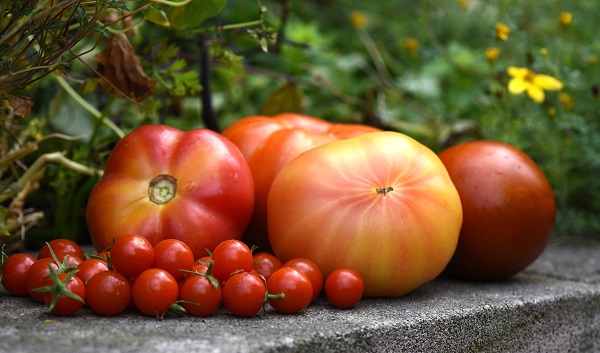The race for the first tomato of the season begins now. For many of us obsessed with picking them as soon as possible, this is the time to nestle seeds into moist planting mix under bright lights.
Choosing the right varieties is an important piece of the puzzle. Some cultivars take 100 days to produce a ripe fruit. Others take less than 50, and those are the plants we’re interested in.
Years ago I bought every early tomato seed I could find in an effort to find the “best” quick-producing tomato. They were grown out at a local farm and much to my surprise, the old standby “Early Girl” won the taste test. There were plants though that ripened sooner but didn’t taste like a garden tomato at all. “Sungold” was another winner. The orange, cherry tomato is sweet, while still maintaining a tomato-like flavor. I’ve picked them as early as June 15.
“Fourth of July” puts on juicy, tasty four-ounce fruits. “Stupice” is an heirloom that produces lots of odd-shaped fruit a little over two inches across. There are countless tomatoes bred to put on fruit early, and every gardener has their favorite.
I’m trying a few others this season to expand my palette of quick producers.
Starting seeds
Starting the seeds is the easy part, but the most important thing to know is you’ll need a bright, artificial light system. I’ve seen seedlings perform in a large south-facing window, but it’s dependent on what kind of sun we get in the spring. There are a wide range of inexpensive LED lights available from local nurseries.
Seeds should be sown in a planting mix, also from the nursery. It’s moistened before the seeds are added. Squeeze the mix after adding water. If it sticks together, but doesn’t drip, the mix is perfect. Use a container with drainage and fill it with the moistened mix. Sprinkle seeds on the soil; add a little more mix on top. Press down on the mix to assure good contact between the mix and seed, then cover the container with clear plastic. It’s important the seed never dries out before germination.
Once they sprout, remove the plastic and grow the seedlings under light until the temperatures outdoors are conducive to planting, around 50 degrees or higher at night.
Preparing the garden
While those little plants are getting ready for the garden, it’s time to get the garden ready for them by warming up the soil. Tomatoes love heat, and there are a few ways to increase the temperature of the garden before planting time. My favorite way is to cover the bed with black landscape fabric since it’s breathable, allowing rain to reach the soil. There are individual soil warmers filled with water called Wall O’ Water season extenders. They are put into place weeks before planting to warm up the garden soil. Amend the soil with compost, as it’s the best way to give the plants what they need.
Before the plants are brought out for planting from under the lights, they need to be hardened off to get them ready for the variables of spring weather. Expose the seedlings to the outdoors for a few hours at first; gradually increasing time outside over a week, then the plants will be ready for the garden.
Ever heard of horizontal planting?
One trick I like to use for tomatoes is called horizontal planting. This is particularly effective if the plants are a little too tall or leggy. A shallow trench is dug in the tomato bed and then the plant is prepared for planting. Strip all the bottom leaves off the plant, turning it on its side and gently placing it in the trench. Add the back fill, leaving only the very top of the plant above ground. It will stand up straight in a day. If staking the plant, be sure to add the stake immediately, so the stem is not severed later when adding the stake.
This keeps the root zone near the warmth of the first few inches of soil. Another benefit is that the roots are closer to water when it rains.
Keeping early plants healthy
The first planting will be susceptible to fungal diseases like septoria leaf spot and early blight. A layer of mulch at planting time will help by stopping the soil-borne spores from splashing up on the leaves. Removing some of the bottom foliage will allow more distance between the spores and the plant. An organic fungicide can help too if it’s a cold, wet spring. In the northeast, tomatoes are usually planted around the third week of May through Memorial Day for the first crop of fruit. Experiment with a couple plants earlier with protection, but don’t risk your main crop. Sometimes a mild spring will make you a gardening genius.
Fertilizing newly planted seedlings with a liquid organic fertilizer like Grow will get them off to a good start.
Try succession planting
There’s another way to maximize early-producing tomatoes. One way to beat those fungal issues is to use a technique called succession planting. When planting tomatoes early in the season, leave room for subsequent plantings. ‘Early Girl’ or ‘Sungold’ tomatoes will also thrive in the warm soils of summer. Since they produce fruit quickly, they can be planted through mid-summer. In my zone 6 garden, the last planting is July 4. The varieties love the warm soil and air temperatures.
When planting early and late, you’ll be picking the first and last tomatoes of the season, and those are the kind of bragging rights every gardener enjoys.
Doug Oster is editor of Everybody Gardens, a website operated by 535Media, LLC. Reach him at (412) 965-3278 or doster@535mediallc.com. See other stories, videos, blogs, tips and more at EverybodyGardens.com.






































